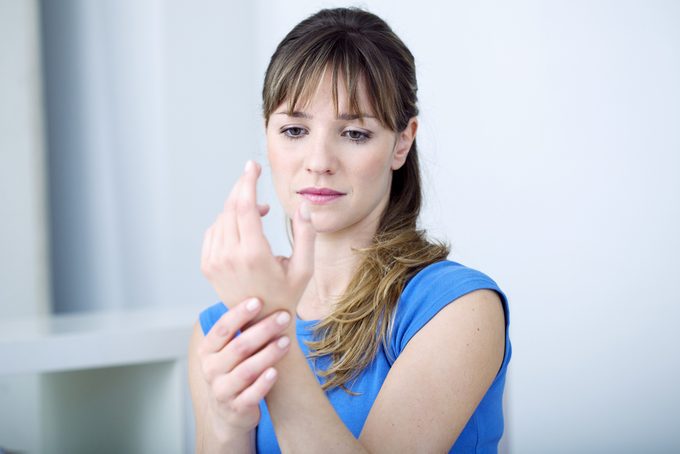How To Relieve Painful Rheumatoid Arthritis Symptoms
A combination of therapies is now the best way to deal with rheumatoid arthritis.

If you don’t think about your joints often, that’s probably a good sign. Most people don’t notice the surface of their bones and the cushioning cartilage sliding smoothly as they go through their day-to-day lives, but for someone with rheumatoid arthritis (RA), it’s impossible to ignore. The cartilage becomes inflamed and breaks down, which can lead to swelling, stiffness and pain. Your heart, lungs and skin can become damaged, while your risk for blood and lymph cancers grows. Unlike osteoarthritis, nicknamed the “wear and tear” arthritis, which can be sustained from an old joint injury or developed over time, RA is a disease in which the immune system attacks healthy joint tissue. RA can happen to anyone at any age, although it’s more prevalent in women and older people.
During a flare-up, white blood cells collect in the joints and mount an inflammatory attack, secreting cytokines that join the fight. One form of cytokine is a protein called tumour necrosis factor (TNF) and another is interleukin-1. In response, the cells being attacked release defensive chemicals called prostaglandins, which cause the joints to become red, sore and swollen. This is the basic process of inflammation that occurs with varying levels of severity.
The cause of RA is unknown, but scientists speculate that it may be an infection, in conjunction with pre-existing genetic factors, that makes some people vulnerable to the disease.
Treating With Medication
While there’s no cure, treatments aim to reduce inflammation. With new advances, patients have even been able to go into a state of “remission,” meaning they have no symptoms and the disease is under control. Traditionally, treatment starts with less aggressive medications, such as acetylsalicylic acid (ASA), and then moves on to stronger ones. Now, doctors start with aggressive therapies to reduce inflammation, stopping the disease – and potential damage – at an early stage.
ASA and other meds, such as naproxen, ibuprofen and indomethacin, fall into the category of non-steroidal anti-inflammatory drugs (NSAIDs), which are available as pills and pain-relieving creams. A newer class of NSAIDs called COX-2 inhibitors modifies inflammation-causing prostaglandins and causes fewer side effects.
NSAIDs can ease pain, but they’re not a treatment on their own. “They’re never strong enough to control inflammation,” says Dr. Trudy Taylor, a rheumatologist at the QEII Nova Scotia Rehabilitation Centre and an assistant professor and director of the rheumatology subspecialty training program at Dalhousie University. “NSAIDs help with pain, but even though their name suggests that they’re anti-inflammatory, they’re not potent enough to get rid of inflammation – they always have to be given with something more aggressive.”
The more-aggressive meds used with NSAIDs to prevent long-term organ and joint damage are called disease-modifying antirheumatic drugs (DMARDs). The most commonly prescribed one is methotrexate (Rheumatrex). Originally developed as a cancer drug, methotrexate given in low doses helps relieve pain and other symptoms by switching off underlying inflammation. “It doesn’t just ease pain; it prevents damage,” says Dr. Taylor.
“That’s what differentiates this class of medications – not only can they help with symptoms but they are also proactive in preventing damage.” The DMARDs typically used for RA treatment are methotrexate, sulfasalazine (Azulfidine), hydroxychloroquine (Plaquenil) and Leflunomide (Arava).
Some of the most effective drugs for controlling RA are anti-inflammatory corticosteroids, some of which are injected directly into joints for relief of RA flare-ups. Biologic response modifiers (BRMs) can also benefit RA sufferers and even halt progressive joint erosion. Some BRMs work by blocking TNF. In tests, patients felt better taking BRMs, and they could be even more effective when used in conjunction with DMARDs. One of the most exciting advances in RA treatment is small molecule therapy, the one currently available being tofacitinib (Xeljanz). This oral med appears to be at least as effective as BRMs, all of which are injectable.
Helpful Lifestyle Adjustments
Patients can also look to daily activities, including the following suggestions, to ease pain and improve mobility.
• Low-impact exercise, such as walking, cycling and tai chi, may have benefits.
• Spa therapy with natural hot spring water has been a traditional remedy for rheumatic pain.
• Gentle massage performed by a registered massage therapist can help relax muscles and maintain flexibility.
• Melted paraffin baths can help relieve pain and hand stiffness, which can be especially prevalent early in the morning.
• Rest is necessary, especially during flare-ups.
• Eating a healthy diet rich in vitamins C and E, which are antioxidant vitamins, may help protect the joints from damage. Zinc, which is found in eggs, dairy, seafood and meat, has antioxidant properties as well. Eating a diet that’s high in these vitamins and minerals could be beneficial, but no foods can cure RA.
Future Therapies
“With RA, it’s not just one part of the immune system that’s driving inflammation for every single person that has the disease; it’s really complex,” says Dr. Taylor. “People are starting to work on more ways to predict which patients will respond to which therapies. It may be clinical criteria, meaning the age and sex of the patient, or it may be genetic criteria.”
While predicting treatments more effectively may not happen for a while, there are some good treatments available right now. “We’re able to get patients into what we call ‘remission’ with medication, where they have no swollen or tender joints, and that’s what prevents damage from happening,” says Dr. Taylor. “It’s not a cure, but it’s control – and that’s huge.”




